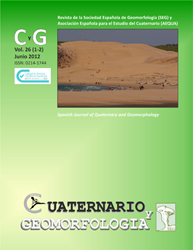Analysis of infiltration temporal variability in a gradient of soil uses degradation in the Central Pyrenees
Keywords:
Infiltration, land use, plant covers, physical conditionsAbstract
The infiltration capacity has been analysed related to the variation of surface physical conditions (moisture and mechanical resistance) of soils from the Central Spanish Pyrenees, taking into account the most representative situations of land uses and vegetal covers. The study was carried out in three experimental catchments, each representative of different environments in terms of soil use and vegetation cover: forested (San Salvador), field abandonment (Arnás) and badlands (Araguás). The three catchments are located nearby and have similar geological and climatic conditions. The study was done through experimental infiltration sets using a big double ring instrument (50 cm water column height). Experiments were performed from autumn 2008 to summer 2009. The infiltration process was analysed on six land uses situations: bare regolith, grass covered regolith, north-facing slope in forested soil, south-facing slope in forested soil, north-facing slope in meadow soil and south-facing slope in pasture soil. Before and after each experiment soil was sampled in order to estimate moisture content (0-1, 0-5 and 5-10 cm depth) and surface mechanical resistance was measured with the help of a pocket penetrometer, providing an idea about previous conditions and its variation. The results suggest a certain effect of moisture conditions on infiltration capacity. However, soil use and slope exposition (North and South) seem to be the most determinant factors. This is related to the seasonal variability of antecedent soil conditions and its dynamics during the experiments. The differences on infiltration capacity associated with slope exposition can be higher than those observed between land uses.Downloads
Download data is not yet available.


